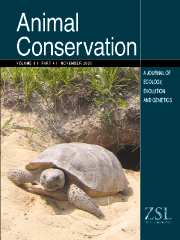Crossref Citations
This article has been cited by the following publications. This list is generated based on data provided by
Crossref.
Tejeda‐Cruz, César
and
Sutherland, William J.
2005.
Cloud Forest Bird Responses to Unusually Severe Storm Damage1.
Biotropica,
Vol. 37,
Issue. 1,
p.
88.
Guevara, Roger
2005.
Saprotrophic mycelial cord abundance, length and survivorship are reduced in the conversion of tropical cloud forest to shaded coffee plantation.
Biological Conservation,
Vol. 125,
Issue. 2,
p.
261.
King, David I.
Hernandez-Mayorga, Martin D.
Trubey, Richard
Raudales, Raul
and
Rappole, John H.
2006.
Vertebrate Conservation and Biodiversity.
Vol. 5,
Issue. ,
p.
473.
Raman, T. R. Shankar
2006.
Forest Diversity and Management.
p.
517.
JOHNSON, MATTHEW D.
SHERRY, THOMAS W.
HOLMES, RICHARD T.
and
MARRA, PETER P.
2006.
Assessing Habitat Quality for a Migratory Songbird Wintering in Natural and Agricultural Habitats.
Conservation Biology,
Vol. 20,
Issue. 5,
p.
1433.
Williams‐Guillén, K.
McCann, C.
Martínez Sánchez, J. C.
and
Koontz, F.
2006.
Resource availability and habitat use by mantled howling monkeys in a Nicaraguan coffee plantation: can agroforests serve as core habitat for a forest mammal?.
Animal Conservation,
Vol. 9,
Issue. 3,
p.
331.
Raman, T. R. Shankar
2006.
Effects of Habitat Structure and Adjacent Habitats on Birds in Tropical Rainforest Fragments and Shaded Plantations in the Western Ghats, India.
Biodiversity and Conservation,
Vol. 15,
Issue. 4,
p.
1577.
Perfecto, Ivette
Armbrecht, Inge
Philpott, Stacy M.
Soto-Pinto, Lorena
and
Dietsch, Thomas V.
2007.
Stability of Tropical Rainforest Margins.
p.
225.
King, Andrew A.
and
Toffel, Michael W.
2007.
Self-Regulatory Institutions for Solving Environmental Problems: Perspectives and Contributions from the Management Literature.
SSRN Electronic Journal,
King, David I.
Hernandez-Mayorga, Martin D.
Trubey, Richard
Raudales, Raul
and
Rappole, John H.
2007.
An Evaluation of the Contribution of Cultivated Allspice (Pimenta Dioca) to Vertebrate Biodiversity Conservation in Nicaragua.
Biodiversity and Conservation,
Vol. 16,
Issue. 4,
p.
1299.
Lozada, Tannya
de Koning, G.H.J.
Marché, Raphael
Klein, Alexandra-Maria
and
Tscharntke, Teja
2007.
Tree recovery and seed dispersal by birds: Comparing forest, agroforestry and abandoned agroforestry in coastal Ecuador.
Perspectives in Plant Ecology, Evolution and Systematics,
Vol. 8,
Issue. 3,
p.
131.
Faria, Deborah
and
Baumgarten, Julio
2007.
Shade cacao plantations (Theobroma cacao) and bat conservation in southern Bahia, Brazil.
Biodiversity and Conservation,
Vol. 16,
Issue. 2,
p.
291.
Beukema, Hendrien
Danielsen, Finn
Vincent, Grégoire
Hardiwinoto, Suryo
and
van Andel, Jelte
2007.
Plant and bird diversity in rubber agroforests in the lowlands of Sumatra, Indonesia.
Agroforestry Systems,
Vol. 70,
Issue. 3,
p.
217.
Norris, Ken
2008.
Agriculture and biodiversity conservation: opportunity knocks.
Conservation Letters,
Vol. 1,
Issue. 1,
p.
2.
Dietsch, Thomas V.
and
Philpott, Stacy M.
2008.
Linking Consumers to Sustainability: Incorporating Science into Eco-friendly Certification.
Globalizations,
Vol. 5,
Issue. 2,
p.
247.
Laube, Irina
Breitbach, Nils
and
Böhning-Gaese, Katrin
2008.
Avian diversity in a Kenyan agroecosystem: effects of habitat structure and proximity to forest.
Journal of Ornithology,
Vol. 149,
Issue. 2,
p.
181.
Rangel-Salazar, Jose Luis
Martin, Kathy
Marshall, Peter
and
Elner, Robert W.
2008.
Population dynamics of the ruddy-capped nightingale thrush (Catharus frantzii) in Chiapas, Mexico: influences of density, productivity and survival.
Journal of Tropical Ecology,
Vol. 24,
Issue. 6,
p.
583.
Perfecto, Ivette
and
Vandermeer, John
2008.
Biodiversity Conservation in Tropical Agroecosystems.
Annals of the New York Academy of Sciences,
Vol. 1134,
Issue. 1,
p.
173.
Attwood, S. J.
Maron, M.
House, A. P. N.
and
Zammit, C.
2008.
Do arthropod assemblages display globally consistent responses to intensified agricultural land use and management?.
Global Ecology and Biogeography,
Vol. 17,
Issue. 5,
p.
585.
Anand, Mandyam Osuri
Krishnaswamy, Jagdish
and
Das, Arundhati
2008.
PROXIMITY TO FORESTS DRIVES BIRD CONSERVATION VALUE OF COFFEE PLANTATIONS: IMPLICATIONS FOR CERTIFICATION.
Ecological Applications,
Vol. 18,
Issue. 7,
p.
1754.


